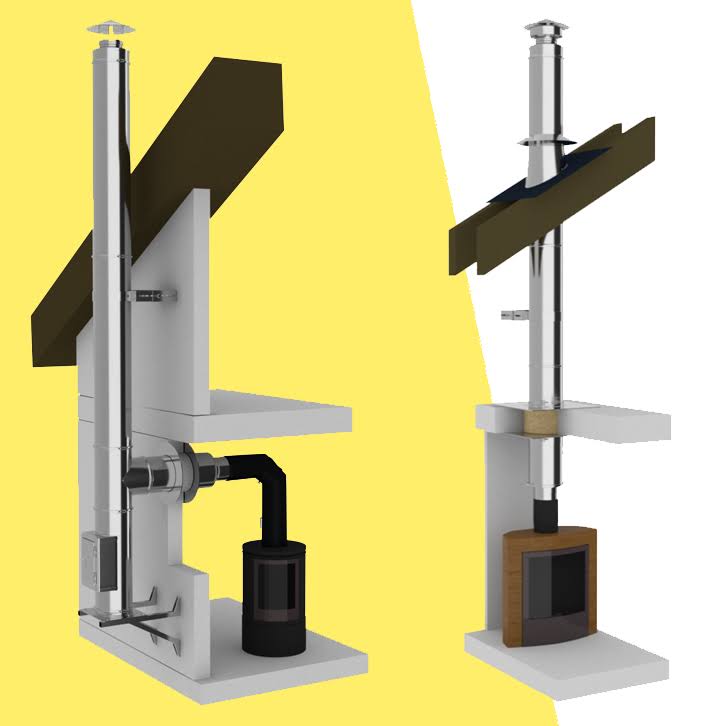TWIN WALL FLUE PIPE

Twin wall flue pipe
Table of contents
Introduction
The different ways of heating
Types of tubes and their differentiation
The single wall tube
The operating system of a double wall insulated tube
The operating principle of a triple wall heat exchanger duct
Energy and environmental impact of fuels
References
Table of illustrations
Energy prices in kWh from 2007-2022 in France (1)
Single wall tube (2)
Double wall insulated tube (3)
Table 1: "Energy" and "greenhouse" impact of domestic wood heating solutions .... (4)
Introduction
What is the difference between a double wall tube and a single wall tube? When should you use a double wall tube instead of a single wall tube? If you are interested in this topic and are looking for answers to these questions, then this article will provide you with the necessary clarification you need.
The different ways of heating
In order to heat the interior of a home, several solutions can be considered depending on individual preferences, including
- The fireplace
- The heat pump
- The radiator
- The stove
In order to stay within the scope of the subject and to be able to explain the system of operation of a double-walled pipe and that of a single-walled pipe, we will look here at only one of these means of heating, in this case: the stove. Choosing a stove as a means of heating a home requires the use of a combustion source, which in most cases is wood.
The energy sector is currently experiencing strong fluctuations due to the soaring prices of electricity and gas, largely due to the current political situation (war in Ukraine). Faced with this rise in energy prices (see graph below), many households are choosing to use stoves, and therefore wood, as an alternative to alleviate this problem.
- Energy prices in kWh from 2007-2022 in France
Source: Ministry of Ecological Transition, quoted by (Selectra).
-
As this illustration shows, using wood as a source of fuel for a stove is the most economical and practical solution.
During combustion, physical phenomena occur such as: heat transfer, release of heat and smoke, evaporation of toxic gases which can represent a real health hazard (cause of asphyxiation), etc.
A tube or flue is therefore imperative to channel smoke, gas and heat. This is where double-walled and insulated tubes come into play.
Indeed, the choice and connection of the tubes according to the right standards are two (2) aspects of capital importance in the installation and the good functioning of the flue (Peigné, 2012 p. 53).
"[...] The thermal draught must be able to be maintained in all circumstances to ensure the proper evacuation of the combustion gases and, moreover, their cooling must not be too great to avoid the condensation of the water vapour contained in the fumes, which can cause the degradation of the flue." (Peigné, 2012 p. 53)
Types of tubes and their differentiation
There are roughly three types of tubes that are present on the heating market today: single-wall, double-wall insulated and triple-wall.
The single wall tube :
Single-wall pipes are used exclusively for connecting pipes; in combination with a single to double-wall adapter, they serve as a connection between the heating appliance (e.g. stove outlet) and the straight double-wall elements.
The operating system of a double-walled insulated tube
A double-wall or double-skin insulated duct is an assembly of double-walled pipes,
(an inner and an outer wall) with an insulation layer between them. Both walls are, in the vast majority of cases, made of stainless steel (corrosion resistance).
"The insulation between the inner and outer tube keeps the outer shell cool, while the flue gas temperature is high enough to ensure good chimney draft (Dokumentation 983, 2015)."
This type of double-walled pipe system not only ensures that the entire heating system functions properly, but also plays a crucial role in protecting the house against fire, as the insulation ensures an ideal temperature and optimal operation of the stove.
The operating principle of a triple-wall heat exchanger duct:
Basically, the triple-walled flue works in almost the same way as a double-walled flue, air and heat duct with a few differences.
"A non-insulated concentric triple tube heat exchanger in which three (3) different fluids circulate: combustion fumes, ventilation air and combustion air. These three (3) gaseous fluids are in parallel flow and are separated by stainless steel metal walls." (Peigné, 2012 p. 135)
Energy and environmental impact of fuels
The different solutions used for domestic heating all have more or less serious impacts, depending on the type of fuel used, on the environment.
While burning wood emits significant pollutants, it is much more preferable to fossil fuels in the fight against greenhouse gas emissions (Institut francais du pétrole, 2006). In addition, wood as an energy source can save a household up to 10% in terms of energy costs compared to other sources. The table below provides summary data on the energy and greenhouse gas impact of the different types of heating systems.
Table 1: Energy and greenhouse impact of domestic wood heating solutions
|
Home heating solutions |
Energy" impact |
Greenhouse effect" impact |
|
|
Fuel |
Equipment |
kWh EF useful/ kWhEP non-ENR |
Kgeq CO2/kWhEF useful |
|
Wood chips Wood logs Wood logs Wood pellets Gas Fuel Electricity |
Boiler (n=75%) Boiler (n=70%) Stove (n=65%) Stove (n=85) Boiler (n=95%) Boiler (n=95%) Convector (n=100%) |
20 14 13 6 0,8 0,7 0,3 |
0,033 0,033 0,040 0,042 0,222 0,466 0,180 |
Source: (Peigné, 2012 p. 54)
-
References
Dokumentation 983. 2015. Abgasanlagen aus nichtrostendem Stahl. Düsseldorf: s.n., 2015.
Institut francais du pétrole. 2006. Cleaning of pollutants from domestic wood combustion. Oil & Gas science and technology. 2006, Bd. 61, 2, S. 213-223.
Ministry of Ecological Transition. [Online] https://www.ecologie.gouv.fr/.
Peigné, Pierre. 2012. Study of a combined ventilation and wood heating system in low energy buildings. La Rochelle, France: s.n., 2012. 2012LAROS357.
Selectra. selectra.info. selectra. [Online] [Zitat vom: 20. 07 2022.] https://selectra.info/energie/guides/conso/energie-la-moins-chere.





